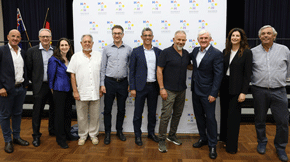The remnants of war
At the Museum of Australian Democracy at Old Parliament House (MoAD), the message about migration in The Gift: Art, Artefacts and Arrivals exhibition is as simple as a suitcase full of nappies and as poignant as a sacred candlestick rescued from the ashes of war.

Artists Hedy Ritterman, , Linde Ivemy, Lousje Skala and Linda Wachtel
Can you imagine receiving a gift that would change your life? Out of the rubble and destruction, from hopelessness and grief comes a second chance in a new country. And it is not just you, but your whole family who will be transformed by that gift.
Four artists have collaborated with migrants who came through the Holocaust to make artworks that talk about suffering, joy and family in a way that relates to all migration.
It is a two way process: migrants bring with them skills, culture, and experiences to enrich this country and thereceive the gift of freedom and hope. Each artist will be in Canberra on Tuesday, February 13 for a lunch that celebrates this moving portrait of migration’s meaning for Australia.
Among the works is a belt that survived three concentration camps, woven bone figures of twins separated forever at Auschwitz and a joyous scroll of family portraits, descendants of two determined migrants who went through hell. At the front of the exhibition sits a much loved and well-worn koala called Kookie, a gift from Arthur Calwell himself, the patron saint of the post-war migrants.
Linda Wachtel, who spent two hours photographing Holocaust survivors Adalek and Marysia Kohn’s family, says that art can have a profound impact on the way people view the world. “In a museum context it gives people a chance to look at issues without being force-fed facts, figures, dogma or slogans. This story, and stories like it, might help reduce the fear people have of the unknown, and people coming to this country from backgrounds they aren’t familiar with she says.

Hedy Ritterman, Linda Wachtel, Linde Ivemy and Lousje Skala
MoAD Director Daryl Karp says that, “This exhibition does what art does best–bringing contentious issues back to the personal, telling stories that may open hearts and minds. The idea of combining history and art through the notion of a gift was a perfect opportunity to make a small, beatiful formed creative experience that punches above its weight. I’m really proud of that.”
Noting that The Gift: Art, Artefacts and Arrivals is set in the building where decisions ranging from welcoming Vietnamese boat people to enforcing the White Australia policy were made, Ms Karp says that MoAD’s role is to be a place for conversations about big ideas of today.
“The museum is uniquely positioned to start a dialogue about the kind of Australia we want to be, where we come from and where we want to head. And we are trying to do it in a way that has real humanity.”
The significance of the artwork has been recognised by the National Portrait Gallery’s decision to acquire two pieces. “Both of these works clearly relate to the experience of the Holocaust, having significance alongside the fact that Australia has a high proportion of Holocaust survivors globally” National Portrait Gallery’s Angus Tumble said. “They both extend the boundaries of what a portrait can be or do, and in that respect they’ll make valuable contributions to the National Portrait Gallery collection.”
So what you would like to say to a modern migrant? Visitors have been writing, drawing and posting messages on postcards for new Australian migrants. There are warm welcomes, messagesconnecting with family stories, and from 16-year-old Edward, these words: “You will always be welcome, you will always be loved. Our nation was built on migration, this will never change”.
The Gift: Art, Artefacts and Arrivals is open now at the Museum of Australian Democracy at Old Parliament House. For more information visit www.moadoph.gov.au.
The exhibition is on until August.










